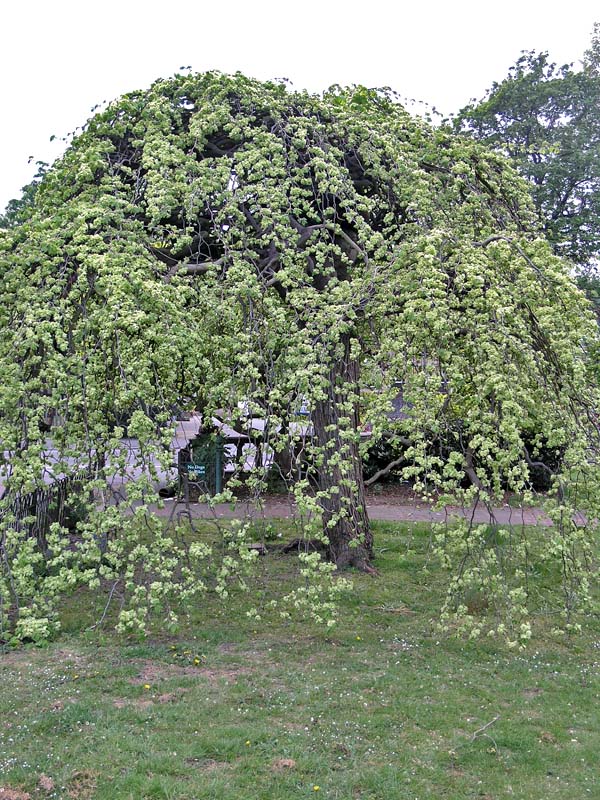
Woody > Ulmus > Ulmus glabra > Ulmus glabra 'Pendula'
Ulmus glabra
'Pendula'
Pendula Weeping Elm
Origin: It was discovered in 1816 in Perth, Scotland, from there the stock was bought and sent to Germany and Poland where it was then distributed to the rest of the world.
Mike's
Opinion


"
This is a slow growing deciduous tree that has downward arching- weeping branches making it an interesting specimen. It has a dull green colour during the summer and turns a yellow colour during the autumn. As the tree loses its leaves the branches are exposed presenting a strong appearance during the winter months. It is a good lawn or ornamental tree along streets, in parks and gardens.
Michael Pascoe, NDP., ODH., CLT., MSc. (Plant Conservation)
"
| Family |
| Ulmaceae |
| Genus |
| Ulmus |
| Species |
| glabra |
| Cultivar |
| 'Pendula' |
| Category |
| Woody |
| Type |
| Tree (deciduous) |
| Pronunciation |
| USDA Hardiness Zone |
| 4 |
| Canadian Hardiness Zone |
| 5-7 |
| RHS Hardiness Zone |
| H7 |
| Temperature (°C) |
| -34 |
| Temperature (°F) |
| -29 |
| Height |
| 5-10 m |
| Spread |
| 5-10 m |
Photographs
Description and Growing Information
Flowering Period
| General Description |
| The leaves are a dull green during the summer, but turn yellow during the autumn and the bark and twigs are smooth and are a greenish-brown colour. The tree has a very distinct pendulous form very similar to Morus alba 'Pendula'. |
| Landscape |
| It can be planted in urban areas, including parks, along residential streets and as a garden or landscape specimen. Its colour and flat-topped shape makes it a prominent landscape feature in autumn, the barren branches make the tree even more dramatic in winter. |
| Cultivation |
| Ulmus glabra 'Pendula' does well in most soils and can grow in high alkaline soils of a pH of 8 to low acidic soils of 5.5. It is tolerant of partial shade but prefers full sun. |
| Shape |
| The tree has a flat-top with horizontal branches fanning outward that droop down. |
| Growth |
| Medium |
| ID Characteristic |
| The tree branches horizontally at the top producing a flat form, with the branches hanging down at the edges creating an umbrella effect. The leaves are very rough adaxial and hairy abaxial. The bark of the tree is smooth and is a greenish-brown colour. |
| Pests |
| It can suffer from Dutch elm disease, and wet-wood, but can also be affected by Elm yellows, also known as Phloem Necrosis, which slowly kills the tree. |
| Habitat |
| Horticultural origin. |
| Bark/Stem Description |
| When the bark is young, it is smooth and has a greenish-brown colour to it with pale grey lenticels that form horizontally along the branches and twigs. As the tree ages, the older branches form red coloured fissures vertically down the bark. |
| Flower/Leaf Bud Description |
| The buds are hispid, with scales in two ranks and are 12 mm in length The buds are opposite and are a red-brown to dark-brown colour. |
| Leaf Description |
| The leaves are 8-16 cm long with a width of 4-10 cm, they are pinnate, with an obovate shape while the base is oblique. The margins of the leaf are doubly serrate, with the underside of the leaf covered in tiny hairs. The leaf adaxial is very coarse and rough like sandpaper. |
| Flower Description |
| The flowers appear in the early spring before the leaves emerge and are a purple red colour, they occur in clusters along the stems of the tree. |
| Fruit Description |
| Produces indehiscent fruit called a samara which are 5 mm wide. The samara has an oval shape that is tipped at one end and is a dull yellow to white colour they occur in clusters or bundles (umbels) all over the tree. |
| Colour Description |
| The leaves are a dull green during the summer but will turn yellow during the autumn. The bark is a greenish-brown when it is young but as the tree ages it turns a darker brown. The flowers are red to brown, and the samaras are a dull yellow green with a light-red seed in the middle. |
| Texture Description |
| Fine to medium. |
| Notable Specimens |
| Royal Pavilion Gardens, Brighton, England. Ballarat Botanical Garden, Victoria, Australia. |
| Propagation |
| Graft scions of 'Pendula' onto an 2 year old Ulmus glabra rootstock in early spring. |
References
J.C Loudon. An Encyclopedia of Trees and Shrubs. London. Frederick Warne And Co. 1869. Book
Tony Russell. Smithsonian Nature Guide Trees. New York: DK, 2012. Print
